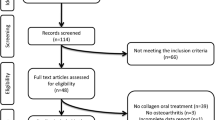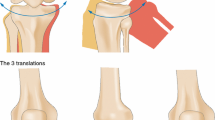Abstract
Purpose
The KOOS questionnaire is used to assess the symptoms and function of patients with traumatic or degenerative knee pathology. The WOMAC score has been validated mainly in the context of knee osteoarthritis. The distribution of these scores in a non-diseased population is not known. The hypothesis was that KOOS and WOMAC scores were influenced by patients’ age, sex, and BMI. The primary objective of this study was to describe, for the first time, the distribution of KOOS and WOMAC scores in a healthy population based on age, sex, and BMI.
Methods
This was a pilot (innovative), cross-sectional, international, multicenter, descriptive study. Persons accompanying patients to our clinic were invited to participate in this study by filling out the KOOS questionnaire. These data were also used to calculate the WOMAC score. The study was designed according to guidelines on pilot studies and planned to enroll a minimum of 30 subjects in each age, gender, and BMI group. Expected KOOS and WOMAC scores by age, gender, and BMI were determined using a linear regression model.
Results
Seven hundred and fourteen subjects were included: 305 men (42.7%) and 409 women (57.3%). For the KOOS score, as age increases, there was a decrease in the “ADL” (p = 0.0001) and “sport” (p = 0.0001) items and an increase in the “symptoms” (p = 0.0025) and “QOL” items (p = 0.0001). Women had lower scores (p < 0.05) than men on all the KOOS items, except “QOL”. For the WOMAC, the “pain”, “stiffness”, and “function” items varied significantly based on age (p = 0.0203) and sex (p = 0.0121). The “stiffness” item varied significantly based on age (p = 0.0005) and sex (p = 0.0477). The “function” item varied significantly based on age (p = 0.0001) and sex (p = 0.0256). The expected value for the KOOS and WOMAC scores in a healthy population without any knee ailments were determined.
Conclusions
The KOOS and WOMAC scores vary significantly based on age, sex, and BMI in a healthy population. This study also provides KOOS and WOMAC values in a population without any knee issue. These scores can be used, in a daily practice, as a reference to assess functional outcomes after a surgical procedure.
Level of evidence
IV.




Similar content being viewed by others
Abbreviations
- ADL:
-
Activities of daily living
- BMI:
-
Body mass index
- KOOS:
-
Knee injury and Osteoarthritis Outcome Score
- OA:
-
Osteoarthritis
- QOL:
-
Quality of life
- WOMAC:
-
Western Ontario and McMaster Universities Osteoarthritis Index
References
Ageberg E, Forssblad M, Herbertsson P, Roos EM (2010) Sex differences in patient-reported outcomes after anterior cruciate ligament reconstruction: data from the Swedish knee ligament register. Am J Sports Med 38:1334–1342
Baldwin JN, McKay MJ, Simic M, Hiller CE, Moloney N, Nightingale EJ, Burns J, 1000 Norms Project Consortium (2017) Self-reported knee pain and disability among healthy individuals: reference data and factors associated with the Knee injury and Osteoarthritis Outcome Score (KOOS) and KOOS-Child. Osteoarthr Cartil 25:1282–1290
Bekkers JEJ, de Windt TS, Raijmakers NJH, Dhert WJA, Saris DBF (2009) Validation of the Knee injury and Osteoarthritis Outcome Score (KOOS) for the treatment of focal cartilage lesions. Osteoarthr Cartil 17:1434–1439
Bellamy N, Buchanan WW, Goldsmith CH, Campbell J, Stitt LW (1988) Validation study of WOMAC: a health status instrument for measuring clinically important patient relevant outcomes to antirheumatic drug therapy in patients with osteoarthritis of the hip or knee. J Rheumatol 15:1833–1840
Bremner-Smith AT, Ewings P, Weale AE (2004) Knee scores in a “normal” elderly population. Knee 11:279–282
Cameron KL, Thompson BS, Peck KY, Owens BD, Marshall SW, Svoboda SJ (2013) Normative values for the KOOS and WOMAC in a young athletic population: history of knee ligament injury is associated with lower scores. Am J Sports Med 41:582–589
Davies GM, Watson DJ, Bellamy N (1999) Comparison of the responsiveness and relative effect size of the western Ontario and McMaster Universities Osteoarthritis Index and the short-form Medical Outcomes Study Survey in a randomized, clinical trial of osteoarthritis patients. Arthritis Care Res Off J Arthritis Health Prof Assoc 12:172–179
Demirdjian AM, Petrie SG, Guanche CA, Thomas KA (1998) The outcomes of two knee scoring questionnaires in a normal population. Am J Sports Med 26:46–51
Ehrich EW, Davies GM, Watson DJ, Bolognese JA, Seidenberg BC, Bellamy N (2000) Minimal perceptible clinical improvement with the Western Ontario and McMaster Universities osteoarthritis index questionnaire and global assessments in patients with osteoarthritis. J Rheumatol 27:2635–2641
Escobar A, Quintana JM, Bilbao A, Azkárate J, Güenaga JI (2002) Validation of the Spanish version of the WOMAC questionnaire for patients with hip or knee osteoarthritis. Western Ontario and McMaster Universities Osteoarthritis Index. Clin Rheumatol 21:466–471
Faschingbauer M, Kasparek M, Schadler P, Trubrich A, Urlaub S, Boettner F (2017) Predictive values of WOMAC, KOOS, and SF-12 score for knee arthroplasty: data from the OAI. Knee Surg Sports Traumatol Arthrosc 25:3333–3339
Fillingim RB (2000) Sex, gender, and pain: women and men really are different. Curr Rev Pain 4:24–30
Garratt AM, Brealey S, Gillespie WJ, DAMASK Trial Team (2004) Patient-assessed health instruments for the knee: a structured review. Rheumatology 43:1414–1423
Hambly K, Griva K (2008) IKDC or KOOS? Which measures symptoms and disabilities most important to postoperative articular cartilage repair patients? Am J Sports Med 36:1695–1704
Hambly K, Griva K (2010) IKDC or KOOS: which one captures symptoms and disabilities most important to patients who have undergone initial anterior cruciate ligament reconstruction? Am J Sports Med 38:1395–1404
Kluczynski MA, Marzo JM, Wind WM, Fineberg MS, Bernas GA, Rauh MA, Zhou Z, Zhao J, Bisson LJ (2017) The effect of body mass index on clinical outcomes in patients without radiographic evidence of degenerative joint disease after arthroscopic partial meniscectomy. Arthroscopy 33:2054.e10–2063.e10
Lancaster GA, Dodd S, Williamson PR (2004) Design and analysis of pilot studies: recommendations for good practice. J Eval Clin Pract 10:307–312
McLean JM, Brumby-Rendell O, Lisle R, Brazier J, Dunn K, Gill T, Hill CL, Mandziak D, Leith J (2018) Asymptomatic population reference values for three knee patient-reported outcomes measures: evaluation of an electronic data collection system and implications for future international, multi-centre cohort studies. Arch Orthop Trauma Surg 138:611–621
Monticone M, Ferrante S, Salvaderi S, Rocca B, Totti V, Foti C, Roi GS (2012) Development of the Italian version of the Knee injury and Osteoarthritis Outcome Score for patients with knee injuries: cross-cultural adaptation, dimensionality, reliability, and validity. Osteoarthr Cartil 20:330–335
Oishi K, Tsuda E, Yamamoto Y, Maeda S, Sasaki E, Chiba D, Takahashi I, Nakaji S, Ishibashi Y (2016) The Knee injury and Osteoarthritis Outcome Score reflects the severity of knee osteoarthritis better than the revised Knee Society Score in a general Japanese population. Knee 23:35–42
Ornetti P, Parratte S, Gossec L, Tavernier C, Argenson J-N, Roos EM, Guillemin F, Maillefert JF (2008) Cross-cultural adaptation and validation of the French version of the Knee injury and Osteoarthritis Outcome Score (KOOS) in knee osteoarthritis patients. Osteoarthr Cartil 16:423–428
Paradowski PT, Bergman S, Sundén-Lundius A, Lohmander LS, Roos EM (2006) Knee complaints vary with age and gender in the adult population. Population-based reference data for the Knee injury and Osteoarthritis Outcome Score (KOOS). BMC Musculoskelet Disord 7:38
Rodriguez-Merchan EC (2012) Review article: risk factors of infection following total knee arthroplasty. J Orthop Surg 20:236–238
Rolfson O, Malchau H (2015) The use of patient-reported outcomes after routine arthroplasty: beyond the whys and ifs. Bone Jt J 97-B:578–581
Roos EM, Lohmander LS (2003) The Knee injury and Osteoarthritis Outcome Score (KOOS): from joint injury to osteoarthritis. Health Qual Life Outcomes 1:64
Roos EM, Roos HP, Ekdahl C, Lohmander LS (1998) Knee injury and Osteoarthritis Outcome Score (KOOS)—validation of a Swedish version. Scand J Med Sci Sports 8:439–448
Roos EM, Roos HP, Lohmander LS, Ekdahl C, Beynnon BD (1998) Knee Injury and Osteoarthritis Outcome Score (KOOS)—development of a self-administered outcome measure. J Orthop Sports Phys Ther 28:88–96
Roos EM, Toksvig-Larsen S (2003) Knee injury and Osteoarthritis Outcome Score (KOOS)—validation and comparison to the WOMAC in total knee replacement. Health Qual Life Outcomes 1:17
Roos H, Laurén M, Adalberth T, Roos EM, Jonsson K, Lohmander LS (1998) Knee osteoarthritis after meniscectomy: prevalence of radiographic changes after twenty-one years, compared with matched controls. Arthritis Rheum 41:687–693
Salavati M, Mazaheri M, Negahban H, Sohani SM, Ebrahimian MR, Ebrahimi I, Kazemnejad A, Salavati M (2008) Validation of a Persian-version of Knee injury and Osteoarthritis Outcome Score (KOOS) in Iranians with knee injuries. Osteoarthr Cartil 16:1178–1182
Soininen JV, Paavolainen PO, Gronblad MA, Kaapa EH (2008) Validation study of a Finnish version of the Western Ontario and McMasters University osteoarthritis index. Hip Int J 18:108–111
Stucki G, Meier D, Stucki S, Michel BA, Tyndall AG, Dick W, Theiler R (1996) Evaluation of a German version of WOMAC (Western Ontario and McMaster Universities) Arthrosis Index. Z Rheumatol 55:40–49
Tamura LS, Cazzo E, Chaim EA, Piedade SR (2017) Influence of morbid obesity on physical capacity, knee-related symptoms and overall quality of life: a cross-sectional study. Rev Assoc Medica Bras 1992 63:142–147
Tanner SM, Dainty KN, Marx RG, Kirkley A (2007) Knee-specific quality-of-life instruments: which ones measure symptoms and disabilities most important to patients? Am J Sports Med 35:1450–1458
Wigler I, Neumann L, Yaron M (1999) Validation study of a Hebrew version of WOMAC in patients with osteoarthritis of the knee. Clin Rheumatol 18:402–405
Williamson T, Sikka R, Tompkins M, Nelson BJ (2016) Use of the Knee Injury and Osteoarthritis Outcome Score in a healthy United States population. Am J Sports Med 44:440–446
Wright JG, Young NL (1997) A comparison of different indices of responsiveness. J Clin Epidemiol 50:239–246
Funding
No funding.
Author information
Authors and Affiliations
Contributions
MV: responsible for writing manuscript. MJ: responsible for data collection. BE: methodology. CA: critical revision. ME: review of manuscript after translation. RN: critical revision and approval of the article. CP: critical revision. CE: corresponding author, responsible for writing manuscript.
Corresponding author
Ethics declarations
Conflict of interest
The author(s) declare that they have no competing interests.
Ethical approval
The research ethics committee at our respective healthcare facilities approved this study (No. 2015-023).
Electronic supplementary material
Below is the link to the electronic supplementary material.
Rights and permissions
About this article
Cite this article
Marot, V., Murgier, J., Carrozzo, A. et al. Determination of normal KOOS and WOMAC values in a healthy population. Knee Surg Sports Traumatol Arthrosc 27, 541–548 (2019). https://doi.org/10.1007/s00167-018-5153-6
Received:
Accepted:
Published:
Issue Date:
DOI: https://doi.org/10.1007/s00167-018-5153-6




